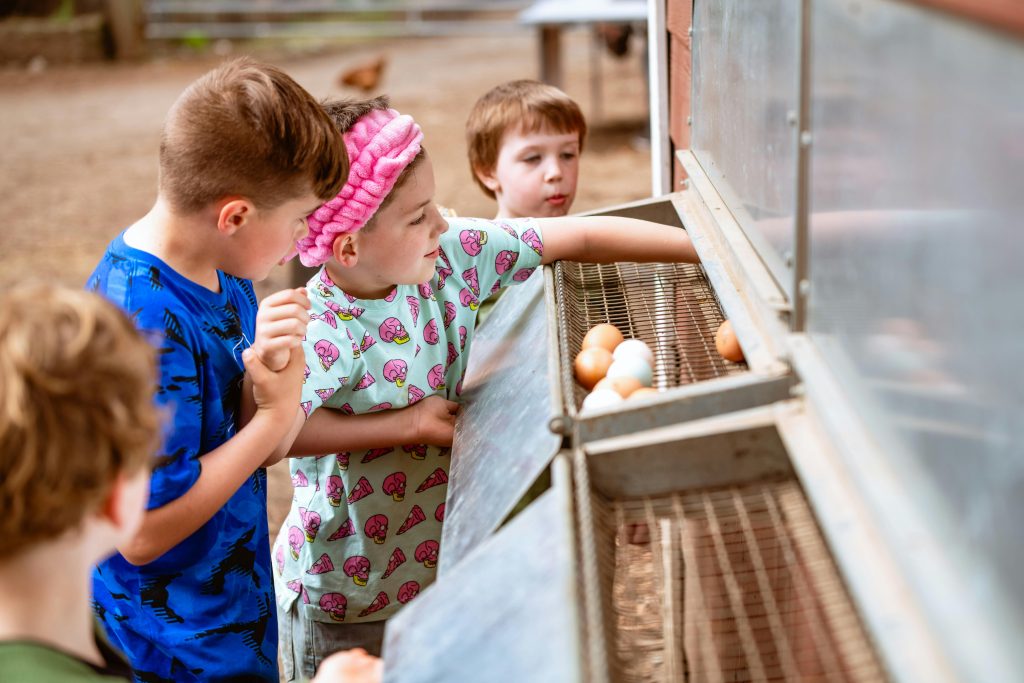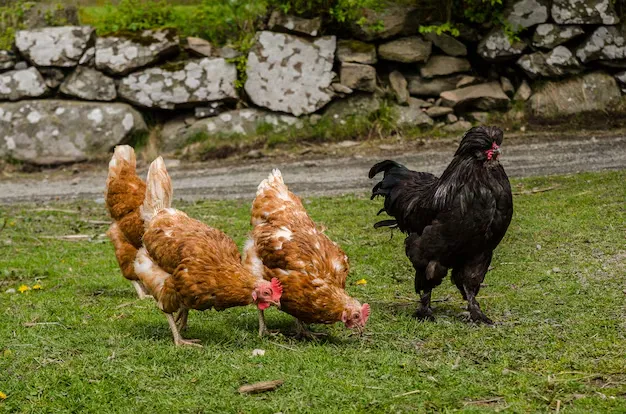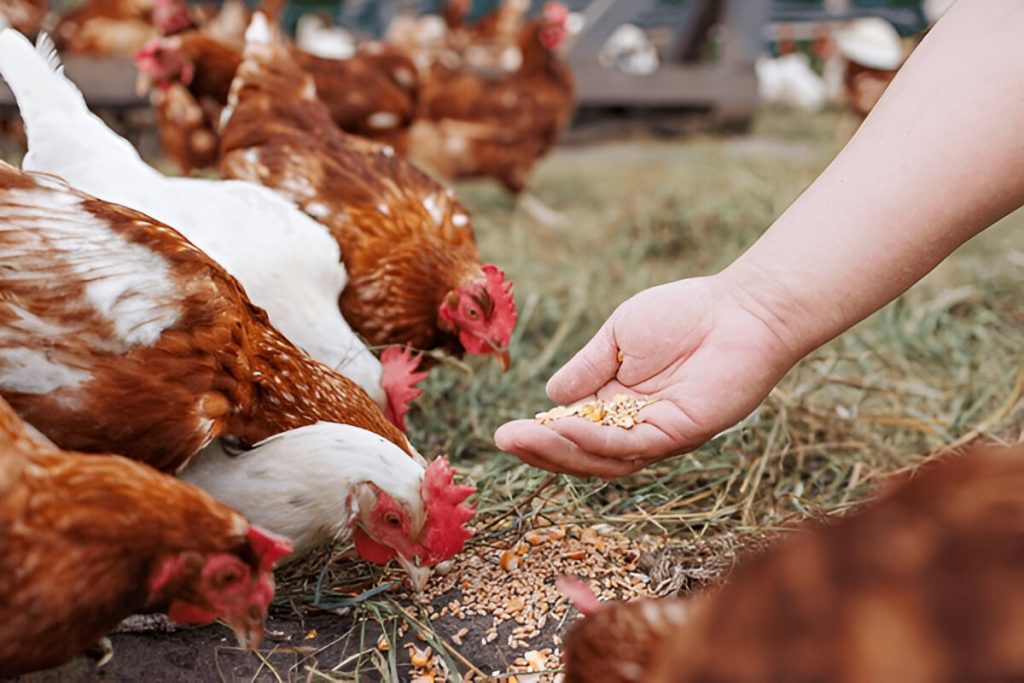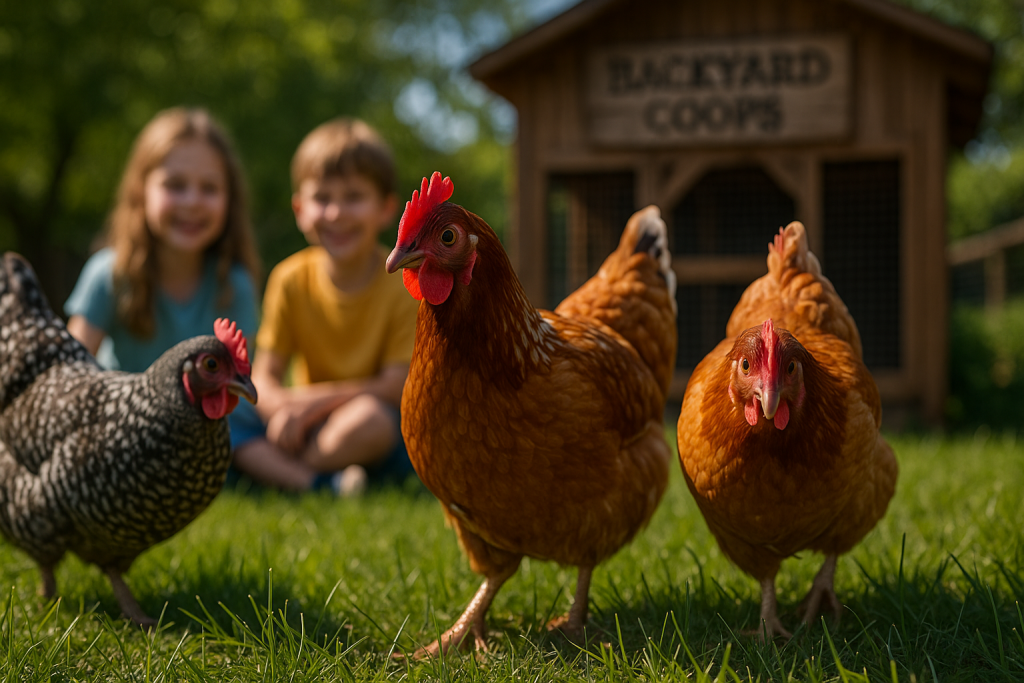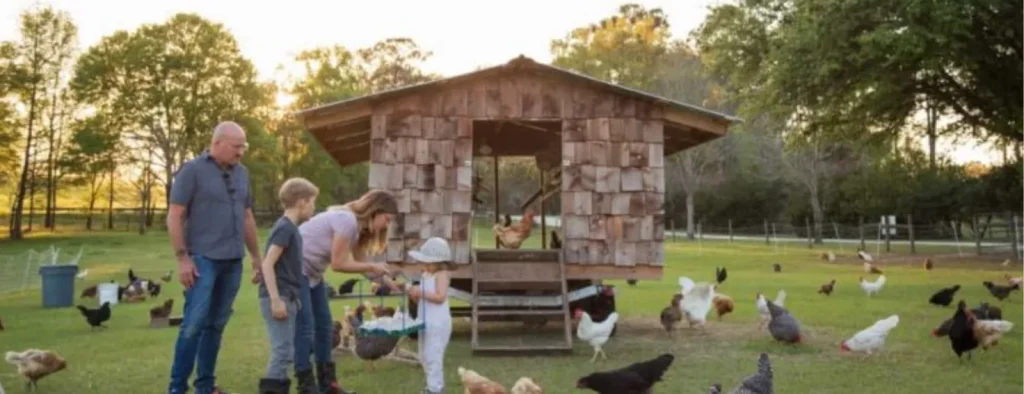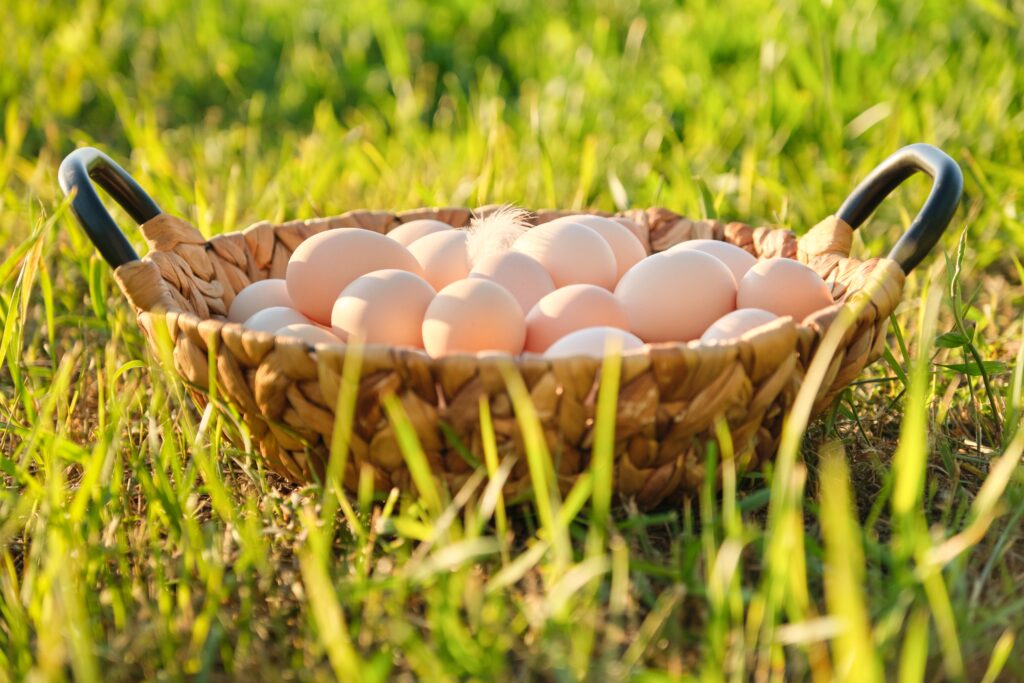Thinking about backyard chickens for beginners and wondering which birds will be gentle hens around little hands? You’re in the right place. Below you’ll find six kid-friendly chicken breeds known for calm temperaments, practical care, and steady egg baskets plus safe-handling tips, coop sizing guidelines, and a simple plan for introducing kids to chickens.
Quick definitions:
- Broody: when a hen stops laying to sit on eggs and hatch them.
- Dual-purpose: breeds kept for both eggs and meat.
- Sex-link: a hybrid where chick sex can be told by color at hatch (helpful for getting mostly hens)
How to Choose Kid-Friendly Chickens:
Match the breed to your climate and coop size
Cold winters? Heavier, fluffy breeds (e.g., Orpington, Cochin, Plymouth Rock) tend to do well. Hot summers? Provide shade and ventilation; dark-feathered birds like Australorps appreciate extra shade in warm weather. Standard guidelines suggest 3–4 sq ft per hen indoors and ~10 sq ft per hen outdoors for layers.
Temperament and handling tolerance
Look for docile chicken breeds noted as calm, friendly, or tolerant of handling useful when children help with chores. Extension guidance specifically calls out temperament as a key selection factor for families.
Egg goals vs. pet goals
If you want lots of eggs, pick strong layers like Australorp or Plymouth Rock. If you want snuggly “pet” birds, Silkies and Cochins shine even if they lay fewer eggs.
Ages of your kids and supervision plan
Gentle breeds still need calm, supervised handling. Think “hands below the bird,” no chasing, and treats to build trust. (See the handling checklist below.
The 6 Best Chicken Breeds for Children
1. Silkie (bantam) the gentle lap chicken
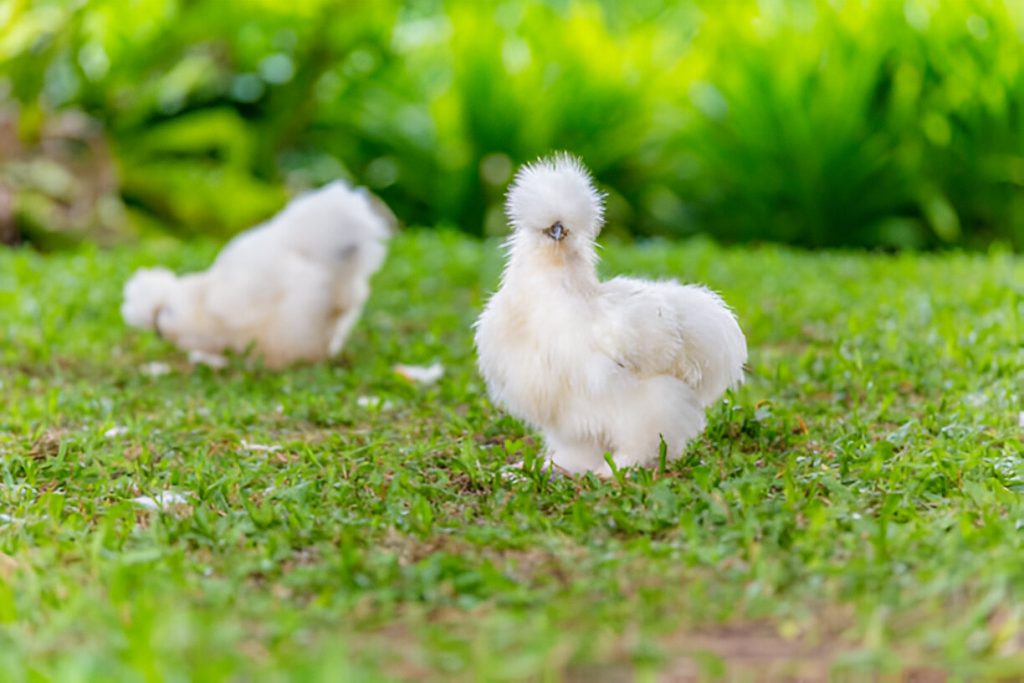
Sit down first; Silkies love calm laps and quiet voices.
Details: Silkies are small bantams with soft, fur-like feathers and black skin (a trait called fibromelanosis). They’re widely loved for very calm, friendly temperaments and strong broodiness (they love their mother). Egg laying is modest, about ~120 small cream/tinted eggs per year (≈2–3/week). Because they’re small and poor flyers, they fit well in small backyard coops and do best with dry runs to protect those fluffy feet. Encourage kids to sit low and offer feed from an open palm. Pros: ultra-gentle, cuddly, great for supervised handling. Trade-offs: lower egg output; vision can be reduced by crests, so keep runs well-protected.
2. Buff Orpington big, calm, and cuddly
Details: Orpingtons are calm, friendly dual-purpose birds with soft feathering that helps in cold weather. Hens typically reach ~8 lb, roosters ~10 lb; many strains lay 4–6 large brown eggs/week (≈200–280/year). They’re often quiet and tolerate confinement, making them a match for suburban coops. Handling tip: teach kids to support the hen’s breast and feet; Orpingtons will usually settle in. Pros: gentle, good layers, cold hardy. Trade-offs: size and docility can make them slower to evade predators ensure solid predator-proofing.
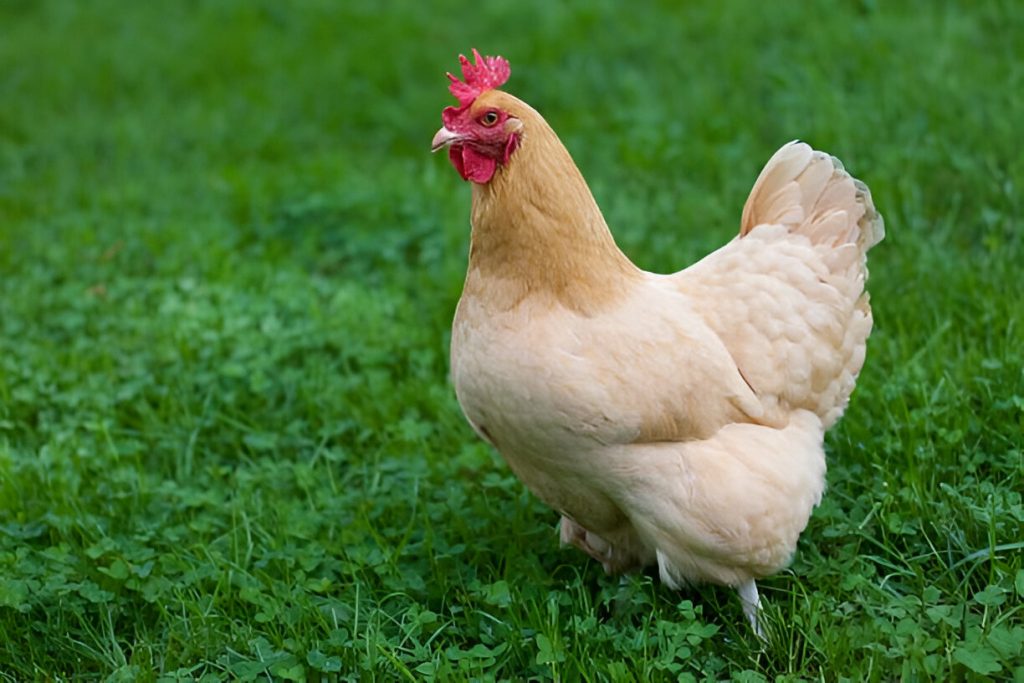
Slow steps, open palms, your Orpington will meet you halfway.
3. Plymouth Rock (Barred Rock) the friendly classic
Barred Rocks love routine same time, same treat dish
Details: Plymouth Rocks are known for calm, docile temperaments and around ~200 large brown eggs/year (≈4/week). Hens average ~7.5 lb (roosters ~9.5 lb). They are praised as chatty but generally quiet, and adaptable to confinement if there’s adequate space and a simple enrichment routine (perches, dust bath, leafy greens on a string). Pros: steady layers, easygoing with people, good first-flock birds. Trade-offs: still need plenty of room and daily engagement to prevent boredom. (The Livestock Conservancy)
4. Australorp the quiet workhorse layer
Shade, water, and a quiet corner keep Australorps happy
Details: Australorps descended from utility Orpingtons and are celebrated for excellent laying many backyard birds producing ~250+ medium/large brown eggs/year (≈5/week). Hens are ~6.5 lb, roosters ~8.5 lb. They’re typically docile, gentle, and do well with kids; offer shade in hot weather, as black plumage can warm quickly. Pros: top-tier layer plus calm temperament. Trade-offs: can get plump if kept only in small runs, add foraging time and enrichment.
5. Cochin giant fluffball with a calm heart
Details: Cochins are friendly, ultra-calm birds, often kept as pets and renowned for broodiness and mothering. Standard hens commonly weigh in the 7–9 lb range. Egg production is lower to moderate and may drop during broody spells (roughly ~100–180+ eggs/year, 2–4/week, varies by line). They’re cold hardy but that heavy feathering means extra shade and dry footing in heat or wet weather. Pros: exceptional temperament, sweet with supervised kids. Trade-offs: lower egg output; feathered shanks need dry bedding.
6. Speckled Sussex curious, social, and pretty
Snapshot: Spotted charmers that are gentle hens and good, steady layers.
Details: Speckled Sussex hens average ~7 lb and typically lay ~180–240 large light-brown eggs/year (≈3–5/week). They’re described as easy to handle, social, and good foragers great for kids who enjoy hand-feeding and watching chickens explore. Pros: friendly, attractive, and versatile. Trade-offs: active curiosity means they appreciate run space and stimulation; supervise young kids during feeding time to prevent crowding.
Safety & Humane Handling Tips for Kids (checklist)
- Wash hands before and after coop time; wear closed-toe shoes. (Biosecurity protects birds and people.)
- Always approach from the side, speak softly, and squat to reduce height.
- Support the hen’s breast and feet; never grab wings or tail.
- Offer treats in an open palm (peas, leafy greens).
- No chasing. If a bird walks away, try later.
- Keep fingers away from beaks near treats; pecks are exploratory, not bites.
- Supervise toddlers; set a 5–10 minute time limit for first sessions.
- After visiting other flocks or feed stores, change clothes and clean footwear before entering the run. (APHIS)
Not Ideal for Small Kids (tactfully)
Some wonderful breeds are simply more active or flighty, which can frustrate young children learning calm handling. Mediterranean breeds (e.g., Leghorn, Minorca) are famously energetic and vocal, while Polish crests can limit vision and startle easily. Consider them later, once kids have experience.
A Simple, Text-Only Recipe for First Introductions
- Set the scene: Quiet morning, birds fed, kids calm.
- Perch practice: Have kids sit on a low step outside the run.
- Open-palm treats: Offer peas or scratch mix; let hens approach.
- Lift with support: One adult demonstrates: hand under breast, other hand supporting feet.
- Touch, don’t grab: When a hen lingers, stroke the back lightly.
- Count to 10: Short holds, then release near flock mates.
- Wrap up: Fresh water for birds; hand-wash for humans.
Coop Size, Run Space & Enrichment Basics
Space and ventilation
Plan 3–4 sq ft per standard hen indoors and about 10 sq ft per hen outdoors. Add vents high on the coop to reduce moisture, and keep bedding dry especially for feather-footed breeds like Cochins and Silkies.
Enrichment and calm behavior
Provide a dust bath, perches at multiple heights, a shaded rest area, and simple “puzzles” (cabbage on a string; scattered forage mix). These outlets reduce squabbles and help quiet chicken breeds stay content.
Biosecurity and predator-proofing
Use an attached, covered run to keep out wild birds (disease vectors) and hawks; close birds in at dusk; fix any gaps. Keep a dedicated pair of coop shoes and a hand-washing routine.
Mini Buying Guide: Quiet breeds & small backyard coop
If noise and space are top concerns, consider Australorp, Buff Orpington, or Plymouth Rock in a small backyard coop with good ventilation and a covered run. Bantam Silkies also suit small spaces (they’re light and easy to carry), though they lay fewer eggs.
Get the Free Coop Starter Checklist
Ready to plan your flock? Beginner Starter Checklist plus get our weekly tips for family-friendly chickens and seasonal care.
- Newsletter sign-up: Get early access to beginner bundles & sales.
FAQs (short answers)
Are bantams good for children?
Yes, especially Silkies. Bantams are small and easier to hold, but they lay fewer, smaller eggs. Ensure predator-proofing and dry runs.
Which chickens are calmest?
Among calm, docile chicken breeds, Cochin and Orpington are standouts; Plymouth Rock and Australorp are also friendly and steady.
Do chickens bite?
Chickens may peck when curious, especially at shiny rings or treats, but calm birds rarely bite. Teach kids open-palm feeding and no chasing.
What age can kids help with chickens?
Start around 4–5 with supervised tasks: refilling waterers, scattering feed, gathering eggs. Always wash hands and keep handling sessions short.
How big should our coop be for 6 hens?
Aim for 18–24 sq ft indoors (3–4 sq ft per hen) and ~60 sq ft of run. More space is better for calm behavior.
How do we teach safe handling?
Squat low, offer treats in an open palm, lift with two hands supporting breast and feet, and stop if a bird struggles. Wash hands before and after.

